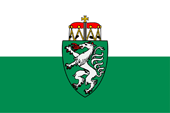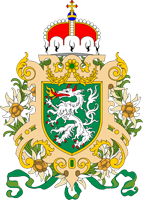Steiermark |
|
|
|
| Übersicht – Contents: | |
Diese Seite ist Teil des Projektes
Steiermark |
|
|
|
| Übersicht – Contents: | |
Flaggen – Flags: |
|
 |
Landesflagge (Landesfarben) – Flag of the country (colours), Seitenverhältnis – ratio = 2:3, Quelle/Source Wikipedia (D), Färbung/colour nach/by Dr. Peter Diem www.peter-diem.at |
 |
Dienstflagge – official flag, Seitenverhältnis – ratio = 2:3, Quelle/Source Wikipedia (D), Färbung/colour nach/by Dr. Peter Diem www.peter-diem.at |
|
|
|
| historische Flagge – historical Flag: | |
 |
19.
Jhd. - 1960 – 19th cent. to 1960, Landesfarben – colours of the country, Seitenverhältnis – ratio = 2:3, Quelle/Source: Flaggen Enzyklopädie |
Bedeutung/Ursprung der Flagge – Meaning/Origin of the Flag: |
|
| Die Flagge von Steiermark zeigt zwei Streifen in Weiß und Grün und wurde in dieser Anordnung der Farben im Jahre 1960 angenommen. Die Farben der Flagge leiten sich aus den Farben des Wappens ab (silberner Panther auf Grün). Vom 19. Jhd. bis 1960 wurde die Flagge mit umgekehrter Farbreihenfolge verwendet. | The flag
of Styria shows two stripes in white and green and was in 1960 adoped with
this sequence of the colours. The colours of the flag are derived from the colours of the coat of arms (silvery panther in green). From the 19th century until 1960 this flag was in use with inverted sequence of the colours. |
| In der Zeit der Monarchie hatte das Land, wie alle Kronländer der österreichischen Krone, seine eigenen, sogenannten Landesfarben, die unter anderem auf horizontal getreiften zwei- oder dreistreifigen Flaggen gezeigt wurden. Die Landesfarben waren sehr oft dem jeweiligen Wappen des Kronlandes entnommen oder wurden duch eine weitere, nicht im Wappen enthaltene Farbe ergänzt, oder sie gingen auf ältere Modelle des Landeswappens zurück (z.B. Krain). Offiziell waren die Landesfarben aber nie geregelt oder festgelegt worden, so dass deren Reihenfolge in der Praxis of variierte oder die Farben gar an sich abwichen. Der österreichische Heraldiker Hugo Gerard Ströhl (1851–1919) hat sich wohl als erster des Themas angenommen und wahrscheinlich um das Jahr 1890 herum die Landesfarben auf den Flaggen bei den jeweiligen Landesbehörden abgefragt und zusammengestellt. Für Steiermark wurden Grün und Weiß als Landesfarben für das Kronland ermittelt. |
In the time of the
monarchy, the country had – like all the other crown lands of the Austrian
crown – its own colours (Landesfarben), which were used amongst others on
horizontally two- or three-striped flags. The colours (Landesfarben) were very often taken from the respective coat of arms of the country or were supplemented by another colour, which not appears in the coat of arms, or they went back to older models of the coat of arms (e.g. Carniola). Officially, the colours had never been regulated or stipulated, so that their sequence varied in practice or even the colors deviated. The Austrian heraldist Hugo Gerard Ströhl (1851–1919) was probably the first to take care of it and asked for the colors (Landesfarben) on the flags at the respective state authorities around 1890 and compiled them. For Styria, green and white were ascertained as the country's colors of the crown land. |
| Österreich trat 1938 als ein Land dem Deutschen Reich bei. Die föderalen Strukturen spielten keine Rolle, sie wurden komplett durch die Gaue der NSDAP abgelöst, die Länder wurden abgeschafft. Ämter und Behörden hatten ab jetzt die Dienstflagge des Reiches zu verwenden. Die entsprechenden Landesfarben existierten möglicherweise weiter, auf jeden Fall aber nicht in Form von Flaggen. Sie wurden möglicherweise vereinzelt an Uniformen der SA oder bei bestimmten Dienstgraden der Hitlerjugend in der Brustschnur verwendet. |
Austria joined the German
Empire in 1938 as one country. The federal structures played no role, they
were completely replaced by the NSDAP districts (NS-Gau), the countries were
abolished. From now on, offices and authorities had to use the empire's
official flag. The corresponding national colors may still have exist, but not in the form of flags. They may have been used sporadically on SA uniforms or in some ranks of the Hitler Youth in the chest cord. |
| Die Flaggen der Österreichischen Bundesländer werden mit oder ohne Wappen gezeigt. Amtlich verwendet, tragen sie immer das Wappen, jedoch darf auch die Bevölkerung Flaggen mit Wappen verwenden. | The flags
of the Federal States of Austria are used with or without the coat of arms. For official use, however, they always show it. The general population is permitted to use this format as well. |
| Für die Farben der Flaggen der österreichischen Bundesländer scheint es keine gesetzlichen Regelungen zu geben, sie werden, da offenbar nicht definiert, in der Praxis in einem gewissen Standardbereich wiedergegeben. Der österreichische Publizist und Medienwissenschaftler Dr. Peter Diem gibt aber Empfehlungen für die Wiedergabe der Farben: Für Steiermark ein helles Grün, am ehesten Pantone 348 entsprechend. |
There do not seem to be
any legal regulations for the colours of the flags of the Austrian federal
states; since they are apparently not defined, they are reproduced in
practice within a usual standard range. However, the Austrian publicist and media scientist Dr. Peter Diem gives recommendations for the reproduction of the colours: For Styria, a bright green, most likely corresponding to Pantone 348. |
| Quelle/Source: Dr. Peter Diem austria-forum.org, Wikipedia (D), Flaggen Enzyklopädie, Volker Preuß, Österreichisch-Ungarische Wappenrolle | |
Wappen – Coat of Arms: |
|
 |
seit/since 1926, Wappen der Steiermark – coat of arms of Styria, Quelle/Source nach/by: Wikipedia (D) |
 |
ca.1890–1918, Wappen Herzogtum Steiermark – coat of arms of the Duchy of Styria, Quelle/Source nach/by: Ströhl, Wappenrolle Österreich-Ungarns, 1890, via Wikipedia (D) |
Bedeutung/Ursprung des Wappens – Meaning/Origin of the Coat of Arms: |
|
| Das grüne Wappen der Steiermark mit dem silbernen Panther stammt aus dem 13. Jahrhundert. Er geht auf das Haus Sponheim zurück, dass im Jahre 1122 zu Herzögen der Steiermark wurde. Die Krone auf dem Wappen war zur Zeit der Monarchie ein üblicher Fürstenhut. Im Jahre 1926 wurde er durch den historischen Steirischen Fürstenhut ersetzt. Der österreichische Heraldiker Hugo Gerard Ströhl hat das Wappen um 1890, in seiner letzten bekannten Ausführung, mit landestypischer Flora umgeben. Für das Herzogtum Steiermark war das Edelweiß, welches die Bedeutung des Landes als Bergregion hervorheben sollten. |
The green coat of arms of
Styria with the silver panther dates from the 13th century. It goes back to
the house of Sponheim, which became dukes of
Styria in 1122. The crown on the coat of arms was a common princely hat at
the time of the monarchy. In 1926 it was replaced by the historical ducal hat
of Styria. The Austrian heraldist Hugo Gerard Ströhl surrounded the coat of
arms ca. 1890, in its last known version, with for the country typical
flora. For the Duchy of Styria this has been Edelweiss, to emphasize the
importance of the country as a mountain region. |
| Quelle/Source: Wikipedia (D), Flaggen Enzyklopädie, Sponheim, Österreichisch-Ungarische Wappenrolle | |
|
Lesen Sie hier: Hintergründe, Geschichte und Fakten zum Thema "Der Löwe in der Heraldik". Ausführungen, Varianten, Entwicklung sowie Panther und Leoparden. |
 ← mehr zum Panther, hier!
← mehr zum Panther, hier! |
Landkarte – Map: |
| Die Bundesländer Österreichs – the federal counties of Austria: |
|
Burgenland • Kärnten
(Carinthia) • Niederösterreich (Lower Austria) |
| Source/Quelle: Volker Preuß |
| die Kronländer Österreich-Ungarns – Crown Lands of Austria-Hungary: |
|
| Quelle/Source: Volker Preuß |
Zahlen und Fakten – Numbers and Facts: |
|
|
|
|
|
|
|
|
|
|
|
|
|
|
|
|
|
|
Geschichte: |
| 400
v.Chr. · Besiedlung durch Kelten 15 v.Chr.–46 n.Chr. · beginnende römische Eroberung, Errichtung der Provinz Noricum 4./5. Jhd. · Invasion der Goten 409–452 · Hunneneinfälle 476 · Absetzung des letzten römischen Kaisers Romulus Augustulus, Ende des (West)Römischen Reiches, Besiedlung durch Bajuwaren 6. Jhd. · Besiedlung durch Slawen, insbesondere durch den slawischen Stamm der Karantanen ca. 740 · Herzog Odilo von Bayern unterstützt die Karantanen gegen die Awaren ca. 750 · Herzog Tassilo III. von Bayern erobert das heutige Kärnten und Steiermark 788 · Bayern wird durch das Frankenreich der Karolinger unterworfen 803 · Einrichtung der "Karantanischen Mark" 907 · Einfälle der Ungarn 976 · Bildung des Herzogtums Kärnten, dabei Angliederung der Marken Istrien und Krain, und der "Mark an der mittleren Mur", der "Mark an der Drau" und der "Mark an der Sann" 1050 · Ottokar aus Steyr wird Markgraf der "Mark an der mittleren Mur", der "Mark an der Drau" und der "Mark an der Sann" (daher Steyrische Marken, Steiermark) 1077 · das Haus Eppenstein erhält die Herzogswürde über Kärnten 1122 · das Haus Sponheim erhält die Herzogswürde über Kärnten 1180 · die Steiermark wird von Kärnten und Bayern abgetrennt und zum Herzogtum unter dem Haus der Traungauer erhoben 1192 · Aussterben der Traungauer, die Steiermark kommt als Erbschaft an das Haus Babenberg von Österreich 1246 · Aussterben der Babenberger, Österreich und Steiermark kommen an die böhmischen Premysliden 1273 · Rudolf von Habsburg wird deutscher König 1278 · Rudolf von Habsburg besiegt die böhmischen Premysliden und erwirbt Österreich und Steiermark 13./14. Jhd. · Besiedlung durch Deutsche 15. Jhd. · Türkeneinfälle 1797–1809 · Französische Revolutionskriege: die Steiermark wird 1797 von den Franzosen besetzt 1848/1849 · Revolution, neue Verfassung: die Titular-Erblande der Habsburger im Kaiserreich Österreich werden zu Kronländern mit eigenen Landtagen umgewandelt, das Herzogtum Steiermark wird so ein Kronland des Kaiserreichs Österreich 1914–1918 · Erster Weltkrieg 12.11.1918 · Proklamation von Deutsch-Österreich zur Republik Österreich, Steiermark wird österreichisches Bundesland 10.09.1919 · Friedensvertrag von Saint-Germain, Südsteiermark wird an das Königreich der Serben, Kroaten und Slowenen (Jugoslawien) angeschlossen 13.03.1938 · Anschluss ganz Österreichs an das Deutsche Reich, an die Stelle des Landes Steiermark tritt der "NS-Gau Steiermark" 27.04.1945 · Proklamation der Republik Österreich "Zweite Republik", Steiermark wird erneut österreichisches Bundesland, bleibt jedoch bis 1955 von britischen Truppen besetzt 1955 · Abzug der Besatzungstruppen |
History: |
| 400 B.C.
· settlement by Celts 15 B.C.–46 A.D. · beginning Roman conquest, establishment of the Province of Noricum 4./5. cent. · invasion of the Goth 409–452 · invasions of the Huns 476 · dismissal of the last Roman emperor Romulus Augustulus, end of the (West)Roman Empires, settlement by Bayuvares 6th cent. · settlement by Slavs, especially by the Slavic tribe of the Carantanes ca. 740 · Duke Odilo of Bavaria supports the Carantanes against the Awares ca. 750 · Duke Tassilo III. of Bavaria conquers the today’s Carinthia and Styria 788 · Bavaria becomes subjected by the Frankish Empire of the Carolingians 803 · establishment of the "Carantanian Mark" 907 · invasions of the Hungarians 976 · establishment of the Duchy of Carinthia, at the same time affiliation of the Marks of Istria and Carniola, and the "Mark of Middle Mur River", the "Mark of Drau River" and the "Mark of Sann River" 1077 · the House of Eppenstein gets the title of Duke of Carinthia 1122 · the House of Sponheim gets the title of Duke of Carinthia 1180 · Styria becomes separated from Carinthia and Bavaria and levied to a duchy under the House of Traungau (Traungauer) 1192 · vanish of the House of Traungau, Styria comes as a inheritance to the House Babenberg of Austria 1246 · vanish of the Babenbergs, Austria and Styria come to the Bohemian Premyslides 1273 · Rudolf of Habsburg becomes German King 1278 · Rudolf of Habsburg beats the Bohemian Premyslides and acquires Austria and Styria 13th/14th cent. · settlement by Germans 15th cent. · invasions of the Turks 1797–1809 · French Revolutionar Wars, Styria is occupied by the French in 1797 1848/1849 · revolution, new constitution: the titular hereditary territories of the Habsburgs in the Austrian Empire become converted to crown lands with their own Landtag (parliament), the Duchy of Styria becomes in this way a crown land of the Austrian Empire 1914–1918 · First World War 12th of November 1918 · proclamation of German Austria to the Republic of Austria, Styria becomes an Austrian federal country 10th of September 1919 · Peace Treaty of Saint-Germain, Southern Styria becomes annexed by the Kingdom of the Serbs, Croats and Slovenes (Yugoslavia) 13th of March 1938 · annexation of Austria to the German Empire, the administrative "NS-Gau of Styria" takes the place of the Country of Styria 27th of April 1945 · proclamation of the Republic of Austria "Second Republic", Styria becomes again an Austrian federal country, but stays occupied by British troops until 1955 1955 · withdrawal of the occupation troops |
| Quelle/Source: Atlas zur Geschichte, Wikipedia (D), World Statesmen, Brockhaus Konversationslexikon 1894-1896, Discovery '97, Volker Preuß |
Ursprung des Landesnamens – Origin of the Country's Name: |
|
| Der Name des Landes "Steiermark" geht auf das Haus der Ottokare zurück, die seit 1050 Markgrafen über die "Mark an der mittleren Mur", die "Mark an der Drau" und über die "Mark an der Sann" waren, und 1188 (kurz vor ihrem Aussterben) sogar noch Herzöge. Der Stammsitz der Ottokare lag in Steyr. Der Name des Herkunftsortes der Grafen hat sich später auf ihr ganzes Land übertragen. | The name of the Country of "Styria" has its roots in House of the Ottokars which were since 1050 Margraves over the die "Mark of Middle Mur River", the "Mark of Drau River" and over the "Mark of Sann River", and in 1188 (shortly bevore their vanish) they even yet became dukes. The birthplace of the Ottokars was in Steyr. The Name of the birthplace of the Counts has transfered to their whole properties. |
| Quelle/Source: Wikipedia (D) | |
| • Reich der Österr. Habsburger (bis 1804) • Kaiserreich Österreich (1804–1867) • Österreich-Ungarn (1867–1918) • Republik Österreich (seit 1918) |
• Empire of the Austrian Habsburgs (to 1804) • Empire of Austria (1814–1867) • Austria-Hungary (1867–1918) • Republic of Austria (since 1918) |